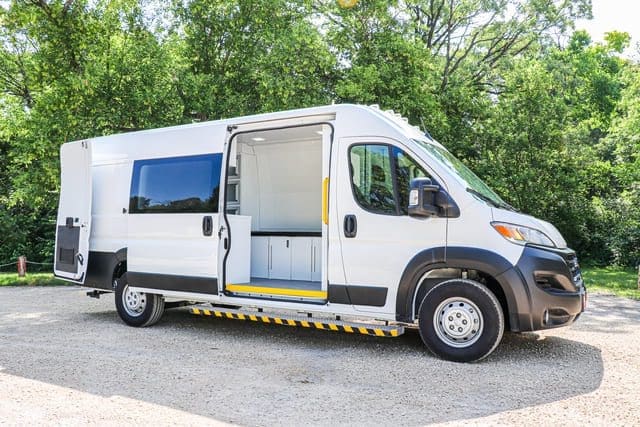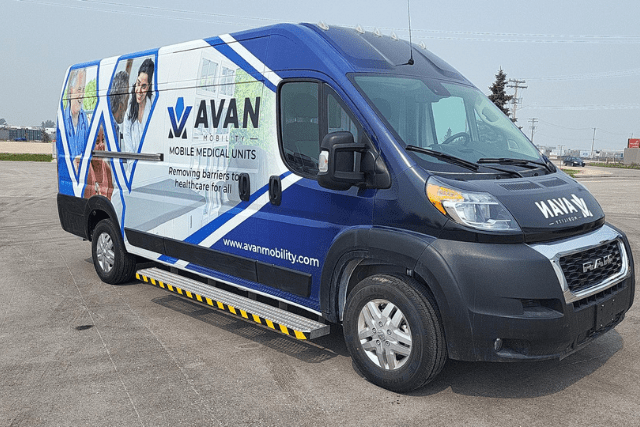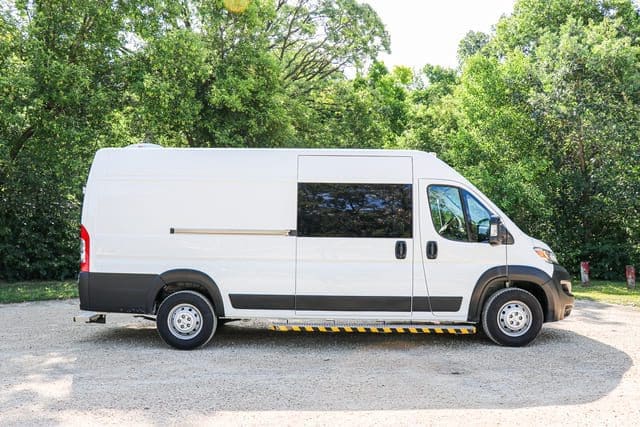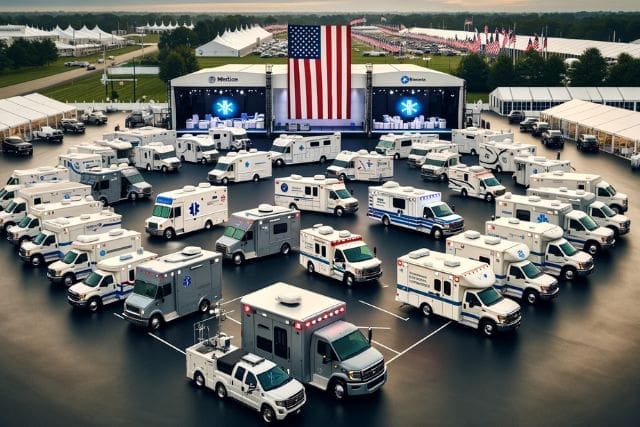You probably didn’t wake up this morning thinking, “I can’t wait to learn about the color options for mobile medical vehicles.” But here you are, and it’s a good question. Color isn’t about looking pretty. It impacts how visible your unit is when pulling into a busy parking lot, how approachable it feels to a nervous patient, and even how easily people recognize your organization.
The problem is, the longer color decisions drag out, the longer people wait for the care they need. What you want is clarity, so you can move forward with confidence and refocus on what matters most: Saving lives.
At AVAN Mobility, we’ve been in this work for more than 10 years. We’ve built over 150 mobile medical units for organizations across the U.S., from CalOptima in California to the Community Clinic of Southwest Missouri. We’re Ford QVM and Stellantis QPro certified, and we’ve earned trust by helping groups like yours reduce barriers to healthcare. We know we’re not the only manufacturer, but our track record shows we know how to get it right.
In this article, you’ll learn:
- What color options are available for mobile medical vehicles
- How these options apply across the U.S.
- What organizations like yours consider before deciding
What color options for mobile medical vehicles are available?

Here’s the straight answer: When it comes to color options for mobile medical vehicles, the choice is usually simple. White. And yes, that’s it. Occasionally, other colors appear, but for most organizations across the U.S., your unit will be delivered in white.
Sounds boring? Maybe. But keep reading to learn why nearly every mobile medical unit you see on the road is white.
Can you order other mobile medical vehicle color options?
Yes, but there are a few catches. If you want your vehicle in anything other than white, it becomes a factory order. That means:
- Timeline: Expect a wait of at least six months before delivery.
- Cost: You’ll usually pay under $4,000 extra. That’s not huge when compared to the overall investment, but it’s still something to weigh.
- Availability: Even when colors are offered, options are limited and depend on what the manufacturer’s factory can support at the time.
So technically, other mobile medical vehicle color options exist, but they’re far less common, slower to get, and add cost. For most organizations, the conversation circles right back to white.
Why is white the default for mobile medical unit color options?
White isn’t a lazy choice. It’s the industry standard because it solves more problems than it creates.
Here are six reasons organizations like yours tend to stick with it:
1. Professional look: White feels clean, sterile, and medical. It signals “healthcare” immediately, the same way a doctor’s coat does.
2. Heat control: In hot states like Arizona, Texas, and Florida, white reflects sunlight better than darker shades. That keeps interior temperatures lower, which matters for patient comfort and equipment safety.
3. Flexibility for decals: White gives you a blank canvas. You can add your organization’s logo, colors, and graphics without clashing backgrounds. Think of it as a billboard that’s waiting for your message.
4. Resale value: When it’s time to retire your unit, a white vehicle appeals to a broader secondary market. Fewer buyers want a purple or lime green clinic van.
5. Easy maintenance: Scratches, touch-ups, and cleaning are simpler with white. Dust and water spots don’t scream for attention the way they do on darker colors.
6. Patient perception: People are more likely to associate a white van with healthcare than with another industry. Pulling up in a bright red or deep black van may create confusion instead of comfort.
3 examples of why white works for mobile medical vehicles
Let’s make this practical.
- Small town in Texas: Imagine your organization is running a mobile vaccination program in rural Texas. You arrive at a community center parking lot in a white mobile medical unit. People see it from a distance and know right away it’s a healthcare service, not a contractor or delivery vehicle. That recognition reduces hesitation and makes them more likely to approach.
- Urban outreach in Chicago: Suppose your group does weekly outreach for basic health screenings in South Chicago. The white vehicle doubles as a neutral presence in the neighborhood. If it were painted black, people might mistake it for a law enforcement van, which could create unnecessary tension.
- Partnership programs in Arizona: If you’re running a mobile clinic program with a local nonprofit, a white vehicle allows you to add bold blue or green graphics that stand out. Those graphics tell your story without fighting against the base color.
These examples show that the choice of color isn’t only about aesthetics, it’s about how people perceive your services and whether they feel safe walking through your doors.
Why is “simple” sometimes the smartest choice with the color of mobile medical units?
When organizations hesitate on color, it’s rarely because patients demand it. More often, it’s an internal debate. Leaders want to present the vehicle as an extension of their brand. That’s understandable, but ask yourself: is the color debate worth slowing down the launch of your program?
White offers a way to move forward without unnecessary delays. And once it’s on the road, you can use vinyl wraps or decals to personalize it. Many U.S. organizations do exactly that, because wraps are flexible, removable, and far easier to manage than waiting on a factory order.
At the end of the day, the question about mobile medical unit color options may feel small compared to decisions about funding or staffing. But it connects back to your larger mission. You want to remove barriers to care and save lives.
It’s not the most glamorous decision, but it’s one that directly impacts how quickly your services hit the road. Think about the people waiting, such as seniors who need blood pressure checks, children who need vaccinations, or community members who don’t have easy access to a clinic. For them, the sooner your vehicle arrives, the better.
Do full wraps and decals change the color options for mobile medical vehicles?

Here’s the part many people forget when thinking about color options for mobile medical vehicles: The base paint color isn’t always the final say. Most medical vans across the U.S. end up getting a full wrap or decals anyway.
Think of it this way. The factory paint is the blank canvas. The wrap is the artwork. Once a wrap goes on, you can transform a plain white van into something vibrant, approachable, and branded to your organization. Blue with bold health graphics? Easy. A warm, welcoming design with community images? Done. Even simple decals with your logo and contact info make the vehicle feel unique without worrying about paint at all.
Here’s the kicker: In our experience, when clients talk through wrap designs, the original paint color almost never comes up as a sticking point. Nobody says, “Wait a second, what about the white under there?” because it simply doesn’t matter once the wrap is on. The wrap defines the look.
And wraps do more than decorate. They:
- Protect the paint underneath from scratches and weather
- Give you the flexibility to change the design later
- Turn your vehicle into a moving billboard that shares your mission everywhere it drives
So if the question of mobile medical vehicle color options feels like a roadblock, remember this: Wraps and decals make the base color nearly irrelevant. Instead of stressing about factory paint, you can focus on what matters most: Creating a design that reflects your mission and helps people instantly recognize your mobile medical unit as a source of care.
What should your organization consider before deciding on mobile medical unit color options?
Now that you know the basics about color options for mobile medical vehicles, let’s talk about the decision itself. It’s easy to get caught up in the idea of choosing a shade that matches your brand colors or stands out on the road. But when you zoom out, the decision has less to do with “what looks nice” and more to do with your organization’s goals, timelines, and the people you serve.
Here are some key questions to help guide your choice:
How soon do you need the vehicle?
If your program launch is urgent, say, you’re covering flu shots in rural Alabama this fall, waiting six months for a factory-painted color might create a serious gap in care. In most cases, moving forward with white and adding a wrap later gets you on the road faster.
How important is branding to your work?
Some organizations, like federally qualified health centers or large nonprofits, want their vehicles to line up perfectly with existing colors. If that’s the case, factor in the cost and delay of a factory color, or lean into wraps and decals that achieve the same effect without the wait.
What’s your climate like?
In hot regions like Arizona, Texas, or Florida, white keeps interiors cooler. That can make a big difference for staff working long days in the vehicle or for sensitive medical equipment that can’t overheat.
How do patients perceive the vehicle?
Color can influence trust. A white mobile unit immediately communicates “medical care.” A bright red or black van, on the other hand, could confuse people or even feel intimidating in some neighborhoods.
What about long-term flexibility?
Think about the future. If you plan to resell the unit or repurpose it for another program down the road, white holds more resale value and adapts more easily to different graphics or decals.
Bottom line: The right choice comes down to matching your decision with the bigger picture. Ask yourself what’s more important: speed, branding, climate, patient comfort, or resale flexibility. Answering those questions honestly will close the gap between debating colors and actually rolling out life-changing healthcare to the people who need it most.
Got any questions about color options for mobile medical units?
You came here because you wanted clarity on color options for mobile medical vehicles. The initial challenge was simple but frustrating: how do you choose the right color without delaying your program or adding unnecessary costs?
Here’s what you learned today:
- White is the standard option, and for good reasons
- Other factory colors are possible, but they add time and cost
- Wraps and decals make the base color far less important
- Your decision should connect back to urgency, branding, and patient trust
At AVAN Mobility, we’ve spent more than a decade developing life-saving mobile medical units that help organizations like yours and Pacific Clinics across the U.S. reduce barriers to healthcare. Beyond the vehicles, our role is helping leaders like you make practical decisions that get care into communities faster. We’ve worked with clinics, counties, and nonprofits from coast to coast, and we know how to guide you through the details that often stall progress. What sets us apart is that we see these vans as more lifelines. If you have questions, click the button below to talk to a mobility expert who will walk with you through every step.
If you’re not ready to talk to a mobility expert yet, here are three resources that can help you move forward:
- How much does a mobile medical unit cost in the U.S.? Helps you understand the bigger investment decisions beyond color.
- 5 types of mobile medical vans: Shows you the variety of vehicles available so you can match the right type to your mission.
- Buying a mobile medical van – Your process with AVAN Mobility :Walks you through the steps of working with us so you know exactly what to expect next.
These articles will give you a deeper look at the decisions ahead and bring you closer to getting the right mobile medical vehicle for your community.




